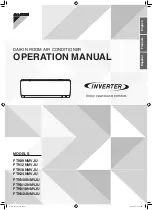
1
(1)
(2) The inverter frequency during operation may be lower than the frequency listed above due to overload current
protection control.
* If Quiet mode is selected, the inverter may stabilize at a frequency lower than those stated above.
For information about Quiet mode, refer to the field application functions.
* If the Power Demand Mode is selected, the inverter may stabilize at a frequency lower than those stated
above. Refer to the Field Application Function for the detail.
(1) The below mentioned Roadmap Control are performed according to the pressure sensor on the outdoor unit
and the 2 temperature sensors attached to the indoor unit heat exchanger coil.
,
* With the roadmap control in heating mode, the pressure detected by the pressure sensor at high pressure
side is converted to the saturation temperature. This converted saturation temperature is called the “High
Pressure Saturated Temperature”.
(2)
(3) The evaporation temperature control and the temperature used to determine the area (A, AB, B, C) for the con-
densation control shown in the figure on the next page, may vary depending on the relationships among factors
including the difference between the room temperature setting and the air intake temperature (=air intake tem-
perature difference) and the difference between the air discharge temperature setting and the air discharge
temperature (=air discharge temperature difference).
(4) Definitions of evaporation temperature and condensation temperature
Lowest heat exchanger temperature (E1, E3) at any indoor unit
* E3 temperature in heating mode is not used for the condensation temperature detection, because it may indi-
cate the temperature of superheated gas.
3-3. Compressor Capacity Control
The compressor operating conditions vary depending on the indoor unit operating conditions and the effects of
indoor heat load, outdoor temperature and other factors. Unit No. 1 (CCU) calculates the required capacity accord-
ing to these operating conditions, and allocates the capacity requirement among the outdoor units, according to the
compressor start/stop rules. Fine adjustments to system capacity control are made by the inverter compressors.
(Depending on the conditions, all inverter compressors may be operating for fine adjustment.)
3-4. Inverter Compressor Capacity Control
The inverter compressor has a center limit value and upper limit value for the operating frequency. These limits
are set for each outdoor unit capacity.
3-5. Forced Compressor Stop
3-6. Roadmap Control
Once a compressor stops, it will not start for a period of 3 minutes (3-minute forced OFF). However, this does not
apply when the compressor was forced to stop as the result of a control operation during the special controls (start
control, defrost control, refrigerant oil recovery control, etc.) which are described later.
This control is performed every 15 seconds.
Evaporation temperature (Te):
Condensation temperature (Tc): Highest temperature among the outdoor unit pressure sensor temperature and
the heat exchanger temperatures (E1) at all indoor units where the heating
thermostat is ON.
Ordinarily, this is the outdoor unit pressure sensor temperature. (If multiple
outdoor units are connected, this is the highest outdoor unit pressure sensor
temperature. )
1
- 5
W-2WAY ECO-i SYSTEM
Control Functions
3. Compressor Control
Summary of Contents for AHX0752
Page 39: ... MEMO 1 34 ...
Page 77: ... MEMO 2 38 ...
Page 91: ... MEMO 3 14 ...
Page 141: ... MEMO 5 32 ...











































